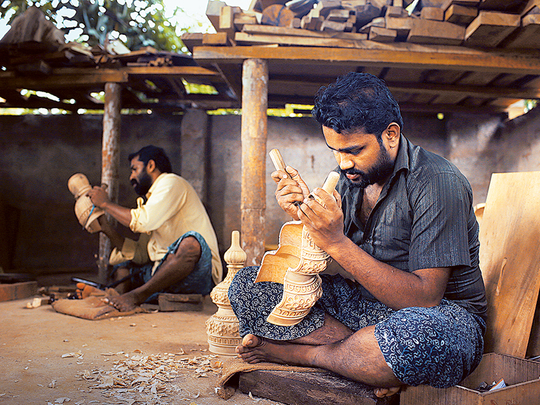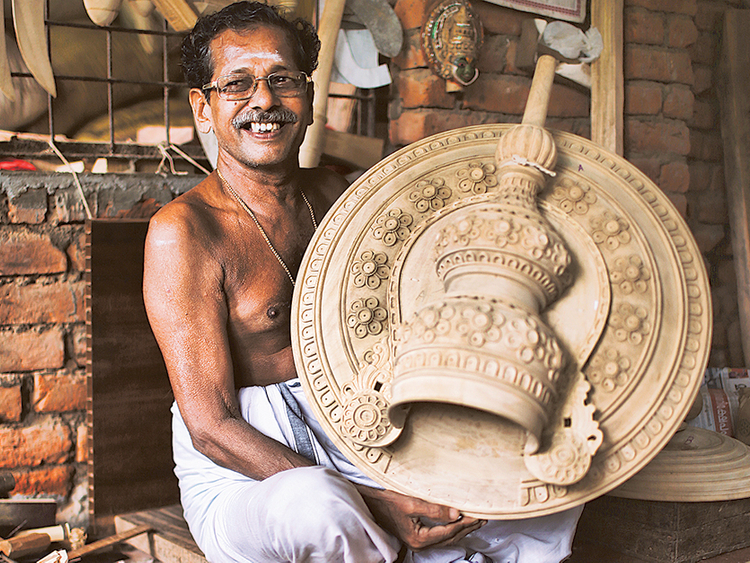
Forty kilometres into the western interiors of Palakkad district in the South Indian state of Kerala lies a picturesque hamlet where vast expanses of verdant paddy fields stretch into the distance, flanked by tall, swaying coconut palm trees. Steeped in idyllic rural charm and surrounded by the flowing tributaries of one of the longest rivers of the state, the Bharatapuzha, not many know that beneath this oasis of calm and serenity, Vellinezhi also shoulders the legacy of a rich cultural heritage.
Credited with keeping alive more than 40 performing art traditions of Kerala, it is here that Kalluvazhi Chitta (school), the most popular and refined style of performing Kathakali — a 300-year-old classical dance form of Kerala — had evolved. Indeed, Kathakali is at the heart of this little village where it is said that at least one person in every house is in some way associated with the dance form — either as performer, makeup artiste, costume maker, singer or musician.
The performing art forms of Kerala are, in general, a harmonious blend of dance, drama, music, expression and colour, and are enacted on stage through hand gestures, facial expressions and body movements. One of the most outstanding features of these classical, folk or ritual dance forms are the elaborate costumes that are a visual representation of the mythological characters portrayed on stage while the large, handmade headgear adds a touch of flamboyance to the dancer and his performance.
Although these centuries-old art forms have survived to the current day despite sweeping socio-political changes in the early part of the last century, what is now in danger of becoming extinct is the traditional art of costume making, an integral component in the staging of these dance forms. Today, 68-year-old Ramankutty Kothavil, a resident of Vellinezhi, is the sole surviving practitioner of the traditional manner of making the “koppu”, which comprises all the ornaments used by a performer. These include the intricate headgear and accessories such as bracelets, anklets, ornate vests with its cascade of necklaces, waist ornaments and even weapons. Together, these lend an added element of grandeur and form part of the attire of the performers.
Yet, his charming smile and old-world humility belie the truth that were it not for his skilled artistry and craftsmanship, Kerala’s celebrated performing art forms such as Koodiyattom, Kathakali, Chakyarkoothu, Nangiarkoothu, Krishnanattam and Ottam Thullal would have been stripped of their stunning ensemble — the very element that breathes life into their characters on stage.
Bare-chested and sitting cross-legged on the floor in his workshop named after his father and located within the compound of his house, Ramankutty proudly displays the various headgear and other accessories for the different mythical characters, including heroes, villains and bird and animal personae that form part of the repertoire of a performance. Variations in each of these are made depending on the type of art form and the individual characters.
Each is crafted to perfection by hand, and intricate floral designs and other patterns are etched out by chiselling the white wood of the rare kumizh (Gmelina arborea) tree, which is lightweight and easily pliable. “Earlier it was difficult to source this raw material as the kumizh is not grown commercially in the region. Our main source was the forest officials who would inform us when a tree was felled,” he says.
Ramankutty, who trained under his father from the age of five, belongs to a family of carpenters. “By late 18th century, the social landscape of Kerala began to transform dramatically with the breakdown of the feudal society and the colonial control of the British. Kathakali thus lost the traditional structure of patronage it enjoyed until then from wealthy landholding families and it went into a steady decline — along with other performing arts — throughout the 19th century,” he says. “And with it was lost to the world the artistry that is integral to its survival.”
It was some time in the 1960s that a trio of Kathakali patrons and enthusiasts visited Vellinezhi in search of a fine carpenter to reinvent and revive the art of making the “koppu”. “My father’s name was suggested alongside a couple of others. Each of them was given an ‘ornament’ to replicate and since my father’s work closely resembled the original, he was chosen to undertake this formidable task.”
Researching the type of wood and the dimensions of the headgear and other ornaments that were in use more than a century ago; Ramankutty’s father, Krishnan Achari, not only identified the wood but also calculated the precise measurements, designs and sizes of the accessories. “It was a painstaking process and took him several years to arrive at these meticulous configurations, which I follow even today,” says Ramankutty.
Speaking of the dedication shown by his father to the craft, he remembers that “even when he was sick and nearing the end of his life, he would lie on the verandah and give instructions as he watched me labour on the work he had begun. It was only after he passed away in 1987 that I worked for the first time without supervision, to honour a commitment he had made to an artist for four sets of Kathakali ‘koppu’.”
Quite early on, however, his prowess as a master craftsman came to light when Kathakali maestro Kalamandalam Gopi happened to don one of the first crowns or headgear that he had made. “A doyen of the art form, it was indeed a great honour when he complimented me on my skills admitting that even during the short breaks throughout the performance, he didn’t take the crown off as it was very light and comfortable.”
“That,” he adds, “has been the biggest recognition I could ever hope to achieve and I am humbled by it.”
A Kathakali headgear, which takes almost a month to complete, weighs only around 450 grams, he says, and because it is made of wood, it can last for decades, with some reportedly lasting well beyond 100 to 150 years. “The costume is the most distinctive characteristic of Kathakali and it is the headgear that is the crown of grandeur of the ensemble because it makes a significant contribution to the aesthetic appeal and dramatic effects of the dance drama,” he says.
Each headgear is designed for the part played by the dancers and the extravagantly ornamented are ones reserved for deities and demons. Interestingly, it is the most villainous character in the epic story “Mahabharata” who adorns the largest headdress.
Two superimposed coronets ending in a bud-shaped finial with a large circular disc attached to it make up the Kathakali headgear. “A simple adjusting mechanism fitted into the base of the hollow dome ensures that it is a perfect fit for any size of head,” says Ramankutty, laughing.
After the entire wood work is done, the “koppu” moves on to a different set of artisans who adorn it with gold foil and coloured glass stones, predominantly in white, red and green. Separating each concentric circle of the halo and coronet are the white stems of the peacock feather.
Ramankutty admits that years of training and artistic finesse are required to handcraft the elaborately designed headgear. “Even as we speak, many of the skill sets associated with this craft are on the wane. For instance, gold leaf has now been replaced by gold foil; silver beads and glass gems have given way to plastic jewels; and there are some who are also making the transition from wood to fibreglass and other materials for the headgear itself.”
He understands that the craft needs to be preserved and is glad to have been able to pass on this legacy to his sons. “There is great satisfaction in knowing that my sons will persevere in keeping alive this art and tradition. In addition, we also have two young interns who have been with us for the past six years.”
The artisan base for traditional “koppu”-making is minimal and it is only with a revival of interest in performing art forms among the younger generation that this craft will survive into the next century, he says.
One of his recent big orders has come from Kerala Kalamandalam, a premier public institution that imparts training in classical art forms of the state. The order is for the complete sets of crowns, ornaments and accessories for the characters of five dance forms including Kathakali. “This will be the last big order in my lifetime,” he says.
In recognition of his work, responsible tourism company The Blue Yonder that works with artisans and communities to preserve the tradition and culture along the Bharatapuzha River, presented Ramankutty Kothavil with a Lifetime Achievement Award in September.
Despite the financial difficulties and hardships he has endured to perpetuate the art, Ramankutty says, “My work is my religion. For me, it is not so much the money — it is a passion; a duty; and my responsibility to see that the tradition of ‘koppu’-making continues.”
Sangeetha Swaroop is a writer based in Dubai.











